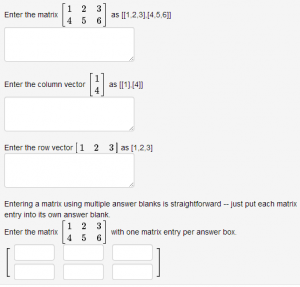Difference between revisions of "MatrixAnswer2"
Jump to navigation
Jump to search
Fabiangabel (talk | contribs) (PGML example link) |
(add historical tag and give links to newer problems.) |
||
| Line 1: | Line 1: | ||
| + | {{historical}} |
||
| + | |||
| + | <p style="font-size: 120%;font-weight:bold">This problem has been replaced with [https://openwebwork.github.io/pg-docs/sample-problems/LinearAlgebra/MatrixAnswer2.html a newer version of this problem]</p> |
||
| + | |||
| + | |||
| + | |||
<h2>Matrix Answer 2</h2> |
<h2>Matrix Answer 2</h2> |
||
Latest revision as of 06:24, 18 July 2023
This problem has been replaced with a newer version of this problem
Matrix Answer 2
This PG code shows how to collect matrix answers using one textbox for the entire matrix a student enters.
- File location in OPL: FortLewis/Authoring/Templates/LinAlg/MatrixAnswer2.pg
- PGML location in OPL: FortLewis/Authoring/Templates/LinAlg/MatrixAnswer2_PGML.pg
| PG problem file | Explanation |
|---|---|
|
Problem tagging: |
|
DOCUMENT(); loadMacros( "PGstandard.pl", "MathObjects.pl", "PGcourse.pl", ); TEXT(beginproblem()); |
Initialization: |
Context('Matrix');
$example1 = Matrix([[1,2,3],[4,5,6]]);
$example2 = $example1->column(1);
$example3 = $example1->row(1);
|
Setup 1: We construct a 2 by 3 matrix and extract its first column and first row. |
Context()->texStrings;
BEGIN_TEXT
The purpose of this question is to show you the syntax needed to enter
matrices in WeBWorK when there is only one answer box for entering a matrix
(which is not obvious)
or when there are multiple answer boxes for entering a matrix (which is obvious).
The examples below should be self-explanatory, so you can jump to them if you want;
however, a detailed explanation follows if you want to read more.
$BR
$BR
Matrices use square brackets to enclose items in lists.
A matrix with one row, such as a row vector, is a comma separated list enclosed by square brackets.
A matrix with more than one row or a column vector is a comma separated list of lists, where each list
uses square brackets to enclose its items.
Your answers must use square brackets to enclose each row in a matrix or in a
column vector. Also, a pair of square brackets is needed to enclose
a matrix with more than one row (e.g., a \( 2 \times 3 \) matrix
and a \( 2 \times 1 \) column vector have multiple rows so they need extra
square brackets, but a \( 1 \times 3 \) row vector has only one row so it does
not need extra square brackets). Your answers may have spaces and line breaks in them,
such as
$PAR
$BCENTER
[ [1, 2, 3], $BR [4, 5, 6] ]
$ECENTER
$BR
$BR
Enter the matrix \( $example1 \) as \{ $example1->string \}
$BR
\{ ans_box(3,30) \}
$BR
$BR
Enter the column vector \( $example2 \) as \{ $example2->string \}
$BR
\{ ans_box(3,30) \}
$BR
$BR
Enter the row vector \( $example3 \) as \{ $example3->string \}
$BR
\{ ans_box(3,30) \}
END_TEXT
Context()->normalStrings;
|
Main Text 1:
Use |
$showPartialCorrectAnswers = 1; ANS( $example1->cmp() ); ANS( $example2->cmp() ); ANS( $example3->cmp() ); |
Answer Evaluation 1: |
Context('Matrix');
$example1 = Matrix([[1,2,3],[4,5,6]]);
|
Setup 2:
Reset the context by calling |
Context()->texStrings;
BEGIN_TEXT
$BR
$BR
Entering a matrix using multiple answer blanks is straightforward --
just put each matrix entry into its own answer blank.
$BR
Enter the matrix \( $example1 \) with one matrix entry per answer box.
$BR
\{ $example1->ans_array \}
END_TEXT
Context()->normalStrings;
|
Main Text 2: |
ANS( $example1->cmp() );
COMMENT('MathObject version.');
ENDDOCUMENT();
|
Answer Evaluation 2: |
